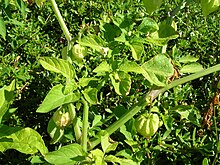bio.wikisort.org - Plant
Physalis angulata is an erect, herbaceous, annual plant belonging to the nightshade family Solanaceae. It reproduces by seed. Its leaves are dark green and roughly oval, often with tooth shapes around the edge. The flowers are five-sided and pale yellow; the yellow-orange fruits are borne inside a balloon-like calyx. It is native to the Americas, but is now widely distributed and naturalized in tropical and subtropical regions worldwide.
| Physalis angulata | |
|---|---|
 | |
| Cutleaf groundcherry | |
| Scientific classification | |
| Kingdom: | Plantae |
| Clade: | Tracheophytes |
| Clade: | Angiosperms |
| Clade: | Eudicots |
| Clade: | Asterids |
| Order: | Solanales |
| Family: | Solanaceae |
| Genus: | Physalis |
| Species: | P. angulata |
| Binomial name | |
| Physalis angulata | |
| Synonyms[1] | |
| |
It is related to, but not to be confused with Physalis peruviana, the Cape gooseberry, a fruit native to, and cultivated in the western Andes, and exported worldwide.
The plant produces edible fruit that can be eaten raw, cooked, jammed, etc. However, all other parts of the plant are poisonous.[2]
Vernacular names
- English common names include: angular winter cherry,[3] balloon cherry,[3] cutleaf groundcherry,[3][4] gooseberry,[3] hogweed,[3] wild tomato, camapu, and occasionally other common names for the genus Physalis.
- In Spanish it is known as bolsa mullaca[5]
- In Malayalam it is known as njottanjodiyan (ഞൊട്ടാഞൊടിയൻ) and mottaampuli(മൊട്ടാമ്പുളി).
- In Indonesian it is known as ceplukan or ciplukan.
- In Suriname it is known as batoto wiwiri.
- In Meru it is known as Nkabakabu.
- In Egyptian it is known as Hrankash(حرنكش).
References
- "The Plant List: A Working List of All Plant Species". Retrieved 14 July 2014.
- "Physalis angulata (cut-leaved ground-cherry): Go Botany". gobotany.nativeplanttrust.org. Retrieved 13 June 2021.
- "Physalis angulata". Germplasm Resources Information Network (GRIN). Agricultural Research Service (ARS), United States Department of Agriculture (USDA). Retrieved 14 July 2014.
- Physalis angulata (USDA)
- Rengifo-Salgado, E; Vargas-Arana, G (2013). "Physalis angulata L.(Bolsa Mullaca): a review of its traditional uses, chemistry and pharmacology". Boletín Latinoamericano y del Caribe de Plantas Medicinales y Aromáticas. 12 (5): 431–445.
External links
- Physalis angulata in West African plants – A Photo Guide.
- "Physalis angulata L." Atlas of Living Australia.
![]() Media related to Physalis angulata at Wikimedia Commons
Media related to Physalis angulata at Wikimedia Commons
Другой контент может иметь иную лицензию. Перед использованием материалов сайта WikiSort.org внимательно изучите правила лицензирования конкретных элементов наполнения сайта.
WikiSort.org - проект по пересортировке и дополнению контента Википедии